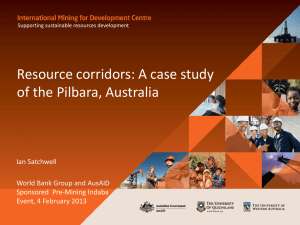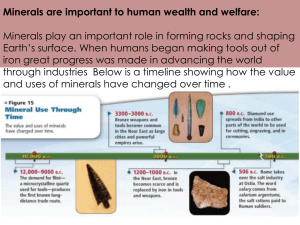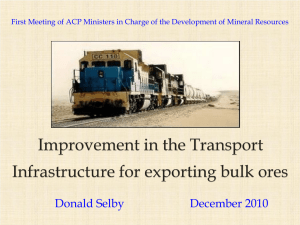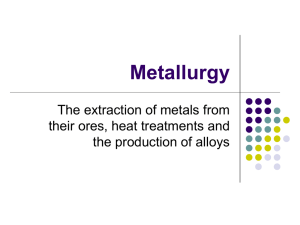Infrastructure and Resource Regions
advertisement
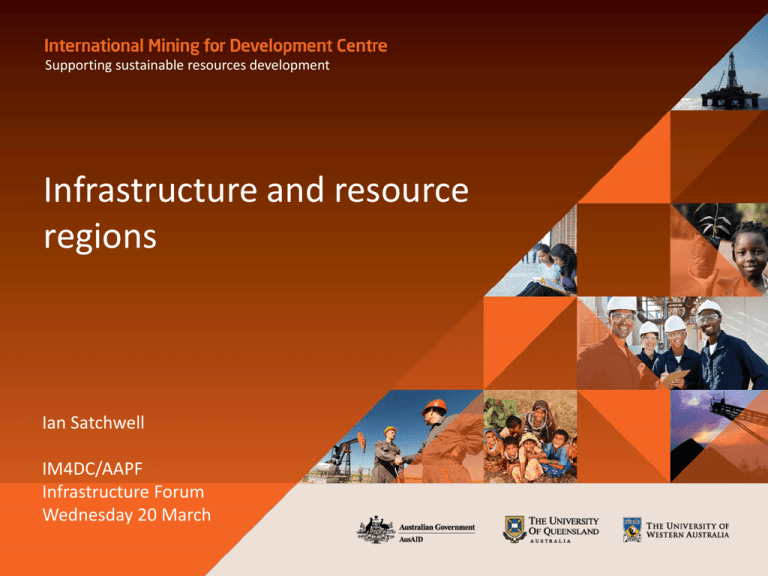
Supporting sustainable resources development Infrastructure and resource regions Ian Satchwell IM4DC/AAPF Infrastructure Forum Wednesday 20 March Outline • Minerals and energy market and development overview ● More than just mining • Pilbara case study ● ● ● ● ● Overview Phases of development Key infrastructure issues though the phases Current planning approaches Some lessons learned • Leading practice in infrastructure planning and development • World Bank Economic Resource Corridor concept 2 Australia’s minerals and energy markets are strong… 1500 1250 Major thermal coal exporters 1000 Major iron ore exporters In 2015-16, iron ore export earnings are projected to reach $68 billion Australian LNG production 55 per cent of worldwide LNG capacity is under construction is located in Australia. By 2015-16, Australia’s LNG exports are forecast to increase to 41 million tonnes, an increase of 126 per centABARES from 2010-11. Source: 3 The Pilbara and Bowen (and Galilee) Basin Regions are well located to supply Asia with mineral and energy products Bowen Basin region 4 Australia’s engineering and construction challenge – the largest investment wave since the 1800s gold rushes* WA & NT projects to 2016: USD220 billion+ LNG, mining DARWIN Offshore petroleum basins Pilbara Region: LNG, iron ore, infrastructure Queensland projects to 2016: USD100 billion+ Base metals BROOME PORT HEDLAND KARRATHA Queensland Western Australia Mid West Region Iron ore, gold, uranium, nickel, PERTH South West Region Alumina, gold *Reserve Bank, Australia Bowen and Surat Basins Coal, CSG, LNG, infrastructure Northern Territory South Australia BRISBANE Copper, uranium, infrastructure New South Wales SYDNEY ADELAIDE CANBERRA Victoria South Australia projects to 2016 USD10 billion+ MELBOURNE HOBART 5 Western Australia case: investment will result in decades of increased production with lower volatility Historic and forecast production value* for WA’s key resources $m Double 2011 value Increased sustaining capital and services 80,000 70,000 Gold Value in $M* 60,000 50,000 Iron Ore 40,000 Nickel 30,000 20,000 Oil/Gas 10,000 Alumina and Bauxite 0 2005 2009 Source: ACIL Tasman analysis 2013 * At ten year average prices 2017 6 Mining and related sectors are bigger than most people think: changing the mindset A new way of thinking about value-adding Source: Australian Treasury and Ed Shan / Minerals Council of Australia METS output is growing at 15 to 20% a year • 4% of national output in 2002-03 • 8.4% in 2011-12 METS contribution to GDP • 6.7% in 2010-11 • Est. 9.4% in 2012-13 Many METS are knowledge- and technology-intensive 7 Mining and related sectors in Australia are bigger than most people think: implications for infrastructure Gross Value Added – resource economy 2011-12 Resource employment by industry 2011-12 Share of nominal GVA, financial year Share of total employment, financial year Resource economy accounts for 18% of GVA: 11.5% directly from extraction and processing; 6.5% from other sectors providing inputs Source: Rayner and Bishop, Reserve Bank of Australia February 2013 Resource economy accounts for 10% of employment: 3.25% directly from extraction and processing; 6.75% from other sectors providing inputs 8 It’s not only about mining: other growth drivers 2 1 Corporate shift to Australia 3 Service and technology sector growth 4 Trade & foreign investment Agriculture and food sector growth 9 Pilbara orientation 10 Pilbara Region dominates Western Australia’s Gross State Product Value of minerals and energy production from Pilbara (2011) Minerals Iron Ore Gold and Silver Copper Manganese and Salt Construction Materials Tantalite, Tin and Gems Total Offshore Petroleum Crude Oil and Condensate Liquefied Natural Gas Natural Gas LPG Butane and Propane Total Other industry sectors Manufacturing Agriculture Retail Value $Millions 60,299 1,006 643 585 72 60 62,665 12,004 9,344 1,401 746 23,495 Value $Millions 350 50 400 Goldfields-Esperance 8% Wheatbelt 2% Mid West 2% Peel 5% Commonw ealth Offshore Petroleum (mostly Pilbara) 21.5% Other 2% Pilbara 59% State Offshore Petroleum 0.5% The Pilbara generates ~ 80% of WA’s minerals and energy production value of $107 billion (2011) The Pilbara has a Gross Regional Product larger than some Australian states, but most flows elsewhere – including to Perth and as returns to capital. 11 Phases in development of Pilbara Region 1960s 1970s 1980s Founded on iron ore Iron ore deposits delineated; First mines, railways, ports and towns established under State Agreements and funded by major mining companies; Population <10,000 Further mines and mine towns established; Project-specific State Agreements written for iron ore, solar salt; Offshore petroleum deposits delineated; Govt. plans for diversified industry in Pilbara 1990s Energy emerges Growth of iron ore production based on Japanese demand; North West Shelf Venture Domgas & LNG projects commissioned; Manganese and gold mining started New mines established by all three major companies; Growth of iron ore production and expansion of NWSV LNG project based on Japanese demand; BHP builds HBI plant; Govt. plans estate for petrochemical industry; Native Title Act passed 2000 2010 2020 Chinese demand Rio Tinto acquires Robe; BHPB merges with Billiton these majors increase iron ore production; BHP HBI plant closes; Expansion of NWSV LNG project; Pluto LNG project; Gorgon JV State Agreement for Barrow Island; Pilbara Cities policy Growth of iron ore production based on Chinese demand; Entry of new iron ore producers; Gorgon LNG construction begins; Fly in / Fly Out workforces; Population 45,000 Wheatstone LNG project construction; Onslow to be a new LNG industry hub; Looking into the future: Iron ore 600 Mtpa (+150% on 2010); LNG 50 Mtpa (+200% on 2010); Population 60,000? 12 Pilbara infrastructure investment Founded on iron ore • Early development 1960s – 1980 ● Three iron ore producers, two salt operations – steady growth, short term planning, based on Japanese demand – all developments under State Agreements on project-by-project basis ● Companies provided most infrastructure – rail, ports, water, power, housing, community infrastructure – infrastructure responsibilities defined by State Agreements – production infrastructure (rail, ports, power, water) planned, funded and built by companies, subject to government approval under Agreements – rail and ports seen as part of production chains - used only by owner – government provided roads, power distribution and water distribution, and education and health services ● Focus of governments was on commitments by companies under State Agreements to future ‘value added’ processing 13 Pilbara infrastructure investment Energy emerges • New opportunities for development 1980s – 2000 ● Offshore natural gas emerges as game-changer in WA economy – State funds Dampier – Perth natural gas 1500 Km pipeline – State energy agency signs take-or-pay for domestic gas to underwrite NWS – all developments under project-by-project State Agreements ● ● ● ● ● ● LNG exports by NWS JV commence and grow threefold New, major gas fields discovered offshore from WA Government plans estate for petrochemicals and other gas processing BHP builds and closes iron ore processing (HBI) plant in $3 billion failure Fly-in / fly-out (FIFO) workforces used extensively to minimise community infrastructure costs Commonwealth passes Native Title Act 14 Pilbara infrastructure investment Chinese demand • Development since 2000 ● Multiple iron ore companies (including Chinese FDI), four LNG developments/operations, several other mining operations – rapid growth, multiple options, long term planning ● Companies still provide production infrastructure – rail, ports, water, power, employee housing – production infrastructure (rail, ports, power, water) used mostly by owner – rail and ports part of production chains ● ● ● Sharing of now-State-owned ports, litigation over sharing of rail ‘Normalisation’ of towns – several now support multiple company operations Governments provide community infrastructure and develop towns – shortage of housing and community facilities and services (eg, education and health); high housing construction and rental costs 15 Future Pilbara production represents a quantum shift in output – with big implications for infrastructure Iron ore Source: Draft Pilbara Planning and Infrastructure Framework 2011 Oil and gas (LNG) 16 Pilbara infrastructure planning changes ● Overall – framework for planning and all infrastructure – cooperative planning within agreed growth parameters – hypothecation of royalty revenues to fund infrastructure ● Ports – move to multi-user ports to allow for investment diversity ● Rail – future multi-user railways with independent operator 17 Pilbara Planning and Infrastructure Framework – consolidation of towns; more resident workers; more local service industry 18 Transport infrastructure – integrated planning; prospect of a multi-user rail line 19 Infrastructure planning changes (2) ● Roads – long-term planning, increased government investment, ● Land, housing and community infrastructure – long-term planning; coordination between companies and government ● Energy – government seeking to establish Pilbara electricity grid ● Water – cooperation between companies and government 20 Utility infrastructure – moving to integrated electricity system 21 Differences in Pilbara population projections – Pilbara Industry Community Council (2010) and WA Planning Commission (2011) WAPC assumes further mining investment and economic transformation beyond 2015 PICC assumes construction will tail off from 2015 22 Karratha growth plan – ensuring infrastructure for service industry 23 What we have learned from Pilbara experience • Predicting the future is very difficult ● a guiding overall vision is needed, with agility to respond to global forces ● uncertainty (in part) can be managed though options approach • Early planning and coordination of infrastructure is essential ● infrastructure development must be timely to match output growth ● infrastructure investment inextricably linked to commodity market risks ● managing risks and rewards essential for government and industry infrastructure ● coordination is essential to minimise costs and to maximise utility and efficiency ● partnerships between government – mining industry – infrastructure providers needed, but government needs to be careful about getting financially involved in mining business • Efficient integrated production chains are vital for global competitiveness of resource development operations • Resource corridors provide holistic approach and options for future development 24 Leading practice in infrastructure planning and development (1) • Set strategic goals that communicate the direction of national or regional development within a sustainability or triple bottom line framework • Agree on scenarios for economic growth and structural change, demographic growth and change, regional development and potential major projects that would result in step-changes in infrastructure requirements ● specification of the nature of threats and remaining uncertainties – as these are key inputs into appropriate risk management planning as a central part of the strategy From Best Practice in Infrastructure Planning and Delivery, Working Paper for Northern Territory Infrastructure Strategy, ACIL Tasman September 2008 Leading practice in infrastructure planning and development (2) • Apply rigorous whole-of-government and whole-of-jurisdiction approaches to infrastructure planning, including: ● Coverage of all classes of infrastructure ● Common approach to assessing all infrastructure ● Cross-agency, top down and bottom up planning ● Consistent approach between levels of government ● Involvement of the private sector • Use demand management approaches to avoid or delay expensive supply investment • Land is a fundamental class of infrastructure. Land use planning is also required to ensure efficient use of land and compatibility of uses Leading practice in infrastructure planning and development (3) • A strategic approach to long-term infrastructure management, maintenance and upgrading • Minimum value thresholds are required to make the assessment process manageable, but need lower thresholds for regional infrastructure, and/or aggregation of multiple projects • Priority on addressing legacy issues arising from past infrastructure under-investment • Mechanisms to allow decision-making in the face of uncertainty, eg “real options" economic tools • Leading practice jurisdictions have a consistent, integrated approach to infrastructure planning, delivery and management and provide a suite of planning tools under “total asset management” Australian and state approaches to infrastructure planning • Infrastructure Australia http://www.infrastructureaustralia.gov.au/ (see Publications) • Strategic Infrastructure Plan for South Australia http://www.infrastructure.sa.gov.au/strategic_infrastructure_plan • NSW State Infrastructure Strategy http://www.infrastructure.nsw.gov.au/state-infrastructure-strategy.aspx • Pilbara Planning and Infrastructure Framework http://www.planning.wa.gov.au/672.asp World Bank Economic Resource Corridor concept • An economic resource corridor is a sequence of investments and actions to leverage a large extractive industry development into broader economic growth and diversification • Investments (public and private) are prioritised and integrated around shared infrastructure and programs, based on an economic and financial analysis of all possible investment options • The approach is flexible and unbundles otherwise very large investments into more manageable (scalable) units. • In each successive step, capacity is built within community and small-to-medium enterprises to realise benefits from emerging opportunities • The integration of public and private plans, together with key environmental and social factors, has a clearly defined geographic footprint • Corridors having economic diversity are designed to interconnect into a national pattern that will evolve organically across time with changing political and market dynamics. Maputo Development Corridor – projects completed Joburg-Maputo Highway PPP- BOT completed Port of Matola/Maputo Upgrades, PPP GAUTENG Coal-based Power Station 2 transmission lines to Matola completed MAPUTO Joburg to Maputo Railway line: Upgrade Liquid Fuels & Petrochemicals: Sasol Pande-Secunda Gas line. PPP Sasol completed Al smelter 500ktpa BHPB completed Maputo Development Corridor Context Maputo Development Corridor Natural Resources Power & Gas Infrastructure Rail, road & pipe link btw RSA & Mozambique; Maputo port, telecom & electricity upgraded Private Sector Private sector investments ($5billion); Strong PPP Business Case / Anchor Projects SMME development (minimal); Strong industrial development (Duvha Power Station, Mozal Smelter, Sasol-Pande gas pipeline) Policy and Regulatory Environment PPP encouraged and facilitated by both governments Political Support Supported by RSA & Mozambique (Heads of States & Transport Ministries) Corridor Authority Competent Project Managers appointed on both sides Stakeholder Participation Strong private sectors involvement; weak CBOs and NGOs input Linkages Strong industrial forward and side-stream linkages; Weak SMME support Cross Border Arrangements Unrestricted flow of people & goods across border; No visa requirements Skills and Technical Capacity Capacitated SOEs (Power Utilities, Finance Institutions and Transport Institutions) Central Development Corridor Bas – Congo Development Corridor Development corridor success factors • Inherent economic and infrastructure potential • Political and bureaucratic commitment throughout the implementation process ● Participation of all economic and infrastructure ministries ● Effective institutional arrangements • Appointment of Project Manager/Coordinator ● Adequate technical in-country project management capacity • Engaging in a targeted interaction with the private sector ● Early involvement of SOEs, private sector, NGOs, CBOs in DC is crucial for its success • Attractiveness of the packaged infrastructure projects • Deliberate action to create opportunities for SMEs Source: Hudson Mtegha, University of the Witwatersrand, February 2013 Contact International Mining for Development Centre The University of Western Australia M460A, 35 Stirling Highway Crawley WA Australia 6009 Tel: +61 8 6488 2489 Email: admin@im4dc.org www.im4dc.org The Energy and Minerals Institute The University of Western Australia M460A, 35 Stirling Highway Crawley WA Australia 6009 Tel: +61 8 6488 4608 Email: emi@uwa.edu.au Web: www.emi.uwa.edu.au The Sustainable Minerals Institute The University of Queensland St Lucia Brisbane QLD Australia 4072 Tel: +61 7 3346 4003 Email: reception@smi.uq.edu.au Web: www.smi.uq.edu.au
